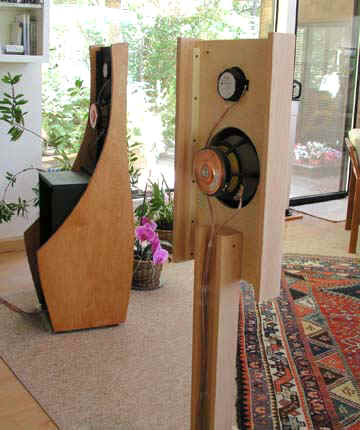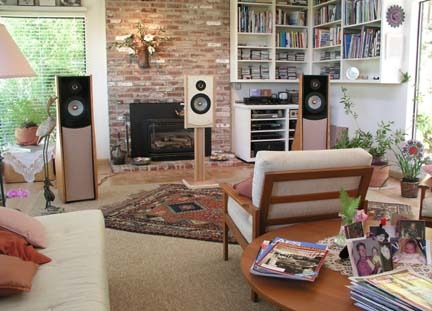Hi guys,
I'm going to build a 2-way centerl channel with the following drivers:
Seas Excel W22
E0022-08S W22EX001
Seas DXT tweeter
H1499-06 27TBCD/GB-DXT
I need some suggestion about the baffle. I already played a bit with Edge.
I was thinking about 650 width x 380 height mm, no H or U shape, maybe with rounded corners for decor purpouse. Pro & cons of such dimensions? Is it to big for the midrange frequencies?
I will Xover, biamp and EQ by Audiolense, so irregularities in the FR are not a big concern. I just ask if you see some major flaws in these design
My favourite midwoofer was the Seas W18 magnesium, but in a dipole config, the more air you can move, the better it is... There will be a Sub for <80hz, but anyway, in such a dipole you already need a lot of boost for 80-250 hz, so I think that the W22 is a safer choice
Thanks
I'm going to build a 2-way centerl channel with the following drivers:
Seas Excel W22
E0022-08S W22EX001
Seas DXT tweeter
H1499-06 27TBCD/GB-DXT
I need some suggestion about the baffle. I already played a bit with Edge.
I was thinking about 650 width x 380 height mm, no H or U shape, maybe with rounded corners for decor purpouse. Pro & cons of such dimensions? Is it to big for the midrange frequencies?
I will Xover, biamp and EQ by Audiolense, so irregularities in the FR are not a big concern. I just ask if you see some major flaws in these design
My favourite midwoofer was the Seas W18 magnesium, but in a dipole config, the more air you can move, the better it is... There will be a Sub for <80hz, but anyway, in such a dipole you already need a lot of boost for 80-250 hz, so I think that the W22 is a safer choice
Thanks
Last edited:
Obviously not a good idea, since no replys for a day.
I like dipole speakers for stereo, but prefer monopoles for HT. It would be very difficult to position the mid speaker so that it works like a good dipole should.
I like dipole speakers for stereo, but prefer monopoles for HT. It would be very difficult to position the mid speaker so that it works like a good dipole should.
The issue of course is space! 🙂 If you have lots of space, sure do an open baffle as your center.
If you are going to cross over at 80 Hz, why get such a large woofer? A 15 to 18 cm woofer would be just fine.
If you are going to cross over at 80 Hz, why get such a large woofer? A 15 to 18 cm woofer would be just fine.
Mr. Linkwitz has good web about dipole speakers.
Some info about center channel:
Surround stereo system
Martin
Some info about center channel:
Surround stereo system
Martin
The main reason about open baffle is the clarity of the midrange. You may give a look to this previous post
http://www.diyaudio.com/forums/multi-way/282759-accuton-158-vs-seas-w18-3.html#post4723697
The wall behind the CC would be a bit close, 80cm, but I noticed that the time domain room correction makes a great work: the delayed back wave does not impact with the clarity. It's pretty evident if I disable the time domain correction, leaving only the frequency correction on.
Anyway, my impression is that a (bad) cabinet may have a greater and worse impact on sound quality than the closeness of the rear wall.
http://www.diyaudio.com/forums/multi-way/282759-accuton-158-vs-seas-w18-3.html#post4723697
The wall behind the CC would be a bit close, 80cm, but I noticed that the time domain room correction makes a great work: the delayed back wave does not impact with the clarity. It's pretty evident if I disable the time domain correction, leaving only the frequency correction on.
Anyway, my impression is that a (bad) cabinet may have a greater and worse impact on sound quality than the closeness of the rear wall.
See, since you were asking about a center independently it seemed you didn't have a L&R already, so I assumed, incorrectly, you were building for home theater use.
My center speaker prototype uses ORION midrange and tweeter channel electronics, except that the 120 Hz highpass filters and midrange delay circuits are bypassed. The DPR 1001 is set up for a "Small" center speaker. The cabinet dimensions follow the drawings in the ORION documentation, except that the dress panel is lengthened for cosmetic reasons. I decided not to build a fully finished unit before finding out whether I would keep a center speaker.

The question should be addressed as to how you plan to derive / synthesize the centre channel information. Note that the original date of the sketch included in the full article is 2004 - it's probably fair to say that the past decade or so worth of "value engineering" in the DSP capabilities of mainstream HT receivers has made type of system easier than ever to assemble. While of course a $500 7.1 (or more) multichannel receiver will have far more features & functions than a audio only system would require, there's a lot to be said for the convenience of a single component for the signal processing and power for all but the mono LEF/sub woofer channel.
Edit: I think it's also notable that he chose to use the same drivers for the centre as L&R mains - no doubt in the interest of maintaining what he describes as almost seamless blending of tonal balance. He did also of course state
At this point I am not convinced that a center speaker in my system is worth it, even if it is placed out of sight most of the time. Sitting in front of such speaker is visually highly distractive and its benefit for multi-channel sound is marginal, given the satisfying sound stage that is set up by the ORION.
Last edited:
What's your crossover frequency going to be? From your first post it looks like you'll be having the drivers next to each other (horizontally). Since the Seas W22 is not a small driver, the CTC distance to the tweeter will be quite large, generating horizontal lobing if you cross to high. Not something you want with a center channel unless it's only you on the couch 🙂
thanks zippy2000! No no, vertical alignment of the drivers but I prefer increase the area of the baffle in the width rather than height, since it's a center channel.
Xover frequency about 1,3-1,5 khz. Note that linear phase xover with FIR filters can be shallow in the cross region, and extremely steep outside. So there is absolutely no risk about the break-up frequency of the midwoofer, but the typical 3th order HD spike should be considered. It means that I could even cross just a bit below such spike with the W18, but probably I won't be able to do that with the W22.
I really don't know which midwoofer could fit better... The larger cone area of the W22 is better for the midbass (never forget it's a dipole and must move a lot of air below 250-300hz), while the W18 is wonderful midrange...
Xover frequency about 1,3-1,5 khz. Note that linear phase xover with FIR filters can be shallow in the cross region, and extremely steep outside. So there is absolutely no risk about the break-up frequency of the midwoofer, but the typical 3th order HD spike should be considered. It means that I could even cross just a bit below such spike with the W18, but probably I won't be able to do that with the W22.
I really don't know which midwoofer could fit better... The larger cone area of the W22 is better for the midbass (never forget it's a dipole and must move a lot of air below 250-300hz), while the W18 is wonderful midrange...
- Status
- Not open for further replies.
- Home
- Loudspeakers
- Multi-Way
- Dipole 2-way Center Channel
